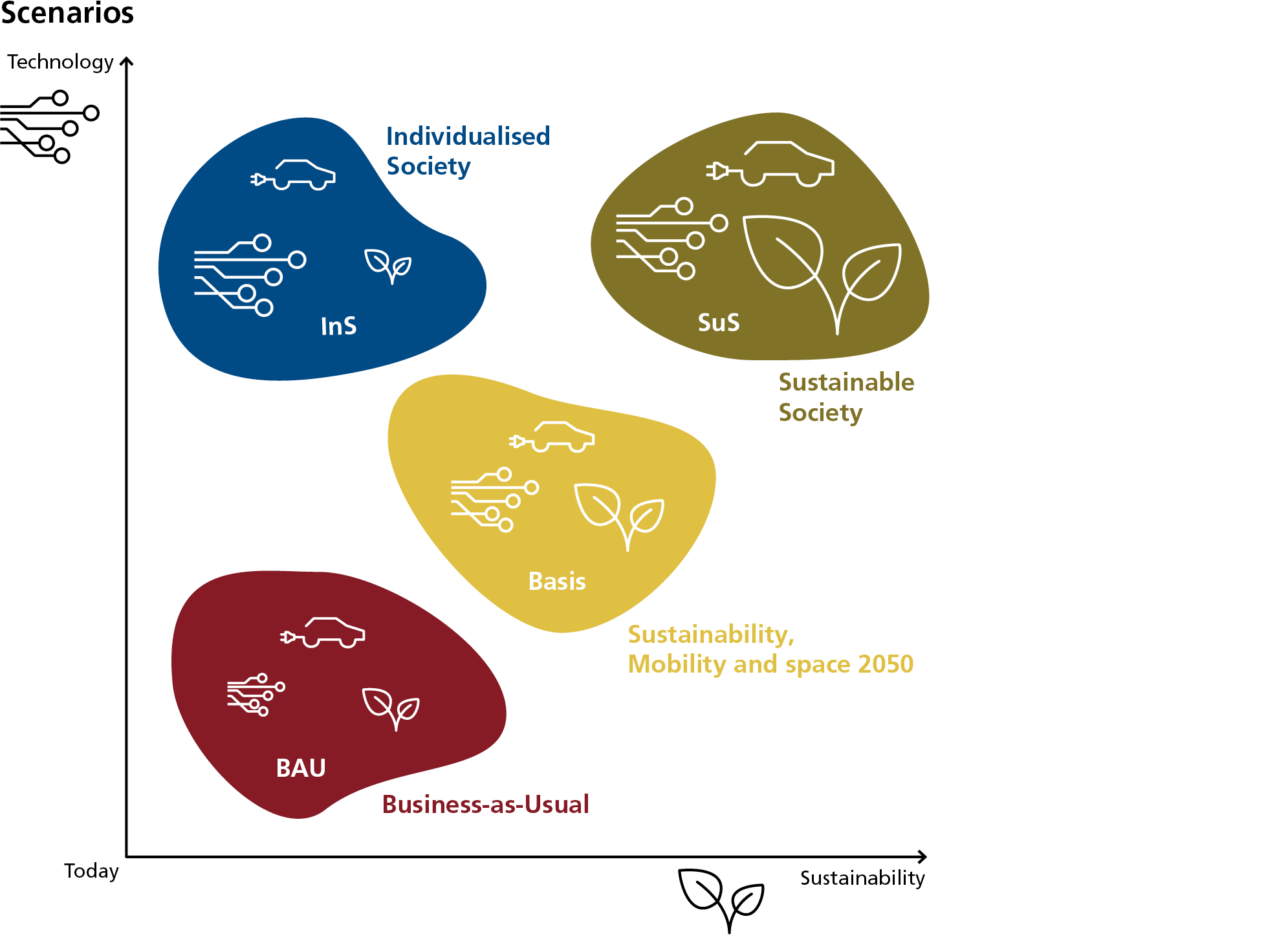Four different scenarios were calculated for Transport Outlook 2050. One important driver is technological development in areas such as automated vehicles, multi-modal transport and electric motors. Another is politicians' and the general public's willingness to do more for sustainable mobility.
The Basis scenario is at the heart of the Transport Outlook. It reflects a move towards resource-efficient mobility of people and goods being aligned with the goals of the Mobility and space 2050 - sectoral plan for transport, program part.
The scenarios do not include targets, but instead are open-ended and explorative. They are based on a variety of assumptions: e.g. about the numbers of automated vehicles on the roads, the popularity of working from home (WFH), and the extent to which politicians are prepared to promote resource-efficient mobility such as public transport, walking and cycling.
Further assumptions regard mobility behaviour. These include the extent to which older people become more mobile and how much we fill the time gained by not commuting with additional leisure activities. The assumptions regarding land use also play a key role: which trips we make and which means of transport we use are affected by whether we live in an urban or rural setting.
Common to all scenarios is the general assumption that prosperity will increase, as will WFH and online shopping. The latter vary in extent according to the scenario.

Basis scenario
This scenario involves a set of transport policy measures that favour sustainability and resource-efficient mobility. A willingness in society to accept these measures is generally assumed in the Basis scenario.
Bicycle use grows as e-bikes become more popular and cycling infrastructure is expanded. Private car use is more expensive than using public transport. Working from home becomes the norm, greatly reducing the amount of travel for work and business. In contrast, leisure-time travel increases markedly. There is a noticeable shift in freight traffic from road to rail, driven by political instruments such as the heavy goods vehicle charge (HGVC). Rail freight transport also benefits from a bundling of freight flows. For the «Basis» scenario, two sensitivity analysis with higher (SH) and lower (SL) population and economic development were also examined according to the scenarios of the Swiss Federal Statistical Office and the economic scenarios of the government.
Sustainable and individualised society scenarios
The two scenarios Individualised Society (InS) and Sustainable Society (SuS) involve a more advanced development and acceptance of new technologies compared to the Basic scenario.
Both scenarios assume that there will be a high volume of automated vehicles. Over 60 per cent of passenger vehicles will be automated by 2050. On-demand transport services – buses that can flexibly be ordered as needed – become established. Electromobility expands at a different rate in each scenario; in Sustainable Society, in 2050 approximately 85 per cent of all cars are electric, whereas in Individualised Society the figure is about 44 per cent. These differing assumptions for the two scenarios look at the purpose for which the technological innovations are used, either for the benefit of the environment (Sustainable Society) or of the individual (Individualised Society).
Sustainable Society scenario
In this scenario, the sense of responsibility towards the environment and the social environment is strong. People care more about sustainable services than about possessions, and there is a great willingness to share. In spatial planning, the emphasis is on inward urban development, making life in urban areas more attractive. Policymakers introduce instruments that make car ownership more expensive. Meanwhile, prices in public transport are made more attractive. One result of these assumptions is that there is less traffic overall than in the other scenarios. In the long term, automated passenger and freight vehicles become established, for example in the form of automated public transport services in cities and on-demand shuttle buses in the countryside. Almost all passenger vehicles are electrically powered. Political instruments such as the heavy goods vehicle charge help to shift a considerable proportion of freight traffic onto the railways.
Individualised Society scenario
In the Individualised Society scenario, individual transport users make use of technological developments primarily for their private benefit. Owning a car is a given, while the trend towards larger vehicles continues. Sustainability is secondary; people are environmentally conscious as long as this does not restrict their own actions and does not cost much. In spatial planning, there is a trend towards further urban sprawl. New neighbourhoods spring up in rural and intermediary areas rather than in urban settings. Public transport receives fewer subsidies, and this pushes up its cost compared to that of passenger car use, which remains low. There is hardly any demand for combining different means of transport or for sharing opportunities. Freight transport by road and rail operates at low cost. Online trade increases at a greater rate than in the other scenarios.
Business-as-Usual scenario
The Business-as-Usual (BAU) scenario is a continuation of the present situation. Technological developments take place, but affect mobility at a slow rate only. Sustainability is not the main issue. Urban sprawl continues at a steady pace. Settlement and housing types remain unchanged and the cost of owning a car is relatively low. Although the number of trips per person decreases slightly as more people work from home and shop online, the volume of traffic remains at a similar level to today since more leisure-time trips are made.

